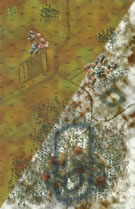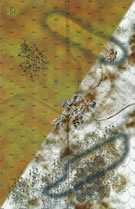|
Dog Eat Dog Maple Leaf Brigade #2 |
||
|---|---|---|
| (Defender) Canada | vs | Soviet Union (Attacker) |
| Formations Involved | ||
|---|---|---|
| Canada |  |
27th Brigade Group |
| Soviet Union |  |
10th Guards "Uralsko-Lvovskaya" Tank Corps |

|
| Overall Rating, 2 votes |
|---|
|
4
|
| Scenario Rank: --- of 964 |
| Parent Game | Maple Leaf Brigade |
|---|---|
| Historicity | Alt-History |
| Date | 1951-10-02 |
| Start Time | 08:00 |
| Turn Count | 32 |
| Visibility | Day |
| Counters | 150 |
| Net Morale | 0 |
| Net Initiative | 1 |
| Maps | 3: 22, 23, 24 |
| Layout Dimensions | 84 x 43 cm 33 x 17 in |
| Play Bounty | 195 |
| AAR Bounty | 161 |
| Total Plays | 2 |
| Total AARs | 2 |
| Battle Types |
|---|
| Inflict Enemy Casualties |
| Road Control |
| Urban Assault |
| Conditions |
|---|
| Off-board Artillery |
| Scenario Requirements & Playability | |
|---|---|
| Elsenborn Ridge | Maps |
| Hammer & Sickle | Counters |
| Maple Leaf Brigade | Base Game |
| Road to Berlin | Counters |
| Introduction |
|---|
|
Unable to stop the Soviet onslaught, the British Army of the Rhine set out to delay the attackers, as pre-war planning directed. The newly-formed NATO alliance needed time to mobilize its troops and bring them to the front; it would be up to the Canadian Brigade Group to buy them that time. The brigade had been designed for just such a task, among others, with a strong recon element and high mobility. |
| Conclusion |
|---|
|
Many of the Canadian officers and men who were fighting the Soviets had seen combat against the fanatical SS in Normandy or German paratroopers and regular Heer units in the Netherlands. They knew that it wasn't necessary to destroy attacking units completely; it was necessary to crush their will to advance. While the Germans would break it took multi-day battles and significant losses to cause them to resign the initiative and accept a passive role. Intelligence indicated that it would take less to demoralize the Soviet Guards and much less to do so to the RKKA units. Of course, accomplishing this required the Canadians to avoid becoming similarly dispirited. With fully-tracked, fully-armored personnel carriers, the Canadians could protect their infantry against much of the firepower the Soviets could throw at them – except for the high-velocity 85mm guns of the new T44 tanks. The powerful 17-pounder anti-tank guns could deal with even these beasts, but they lacked mobility. In order to stop the enemy tanks, the Canadians were going to need to deploy their own tanks. |
| AFV Rules Pertaining to this Scenario's Order of Battle |
|---|
|
| 1 Errata Item | |
|---|---|

|
Kommissars never get morale or combat modifiers. Ignore misprints. (Shad
on 2010 Dec 15)
|
| Soviets want a do-over |
|---|
|
This is a fun scenario, and I think I learned a lot about tactics that I really should have understood by now. The Canadians are defending a road and towns from Soviet attack. They have a battalion of mechanized infantry, a squadron of recce cars and 3 batteries of excellent AT guns. I deployed them in depth on the western 2 of 3 boards, with one company (including the battalion mortars) and 2 AT guns defending a ridge line and town on the middle board, a second company defends the main town on the westernmost board and the last company in reserve behind them. The recce a/c are deployed in a screen in front of the Canadian position, mostly in light woods along the southern edge. The Soviets repeat their tactical mistake from scenario 1, splitting their force into two parallel battalion strength attacks, one aimed at or bypassing the northern ridge, one aiming at the first defended town just south of the ridge. An extra few company of infantry were going to secure the Soviet southern flank, and a battalion of T44s with SMG tank riders were divided between the assault battalions. The Soviets were guards, and had fantastic leadership. Their attack was proceeding well, but at they moved into engagement range of the northern ridge the battalion cohesion was lost. Significant tank losses. In the center, the Soviets decided to bypass the town and press on into the heart of the Canadian position. They lost their momentum and were pinned down by a Canadian counterattack. After about 4 hours, the Soviets had suffered 50% casualties, and I called the game. The Canadians had suffered barely a scratch. The mistake I keep making with the Soviets is to fail to attack in echelons. I'm putting 90% of their combat power on line, instead of concentrating it against a single point in waves. Every attack loses cohesion and momentum, and the Canadians are able to counterattack and stop the Soviets completely. It was easy in Scenario 1 against weakly led RKKA, and still very easy against much more respectable Guards here. Canadian 27th Infantry Brigade has badly bloodied two regiments of Soviets with almost no losses so far. Time for Ivan to get smart and use his numbers correctly. |
| 0 Comments |
| Maple Leaf Brigade #2 - Dog Eat Dog | ||||||||||||
|---|---|---|---|---|---|---|---|---|---|---|---|---|
For this next battle the Canucks have some options for how to deploy their forces, they pick up an extra 17lbr battery for a total of 3 but they are still outnumbered 2.5 to 1. Soviets have more time this scenario, 32 turns, with which to control as many town hexes as possible and clear the E-W road hexes on each board. The Soviet 10th Guards cleared each Canadian roadblock, suffering minimal casualties, their numbers allowed them to maneuver around the Canuck strongpoints to outflank them and in some cases get into the rear. Played using optional rules 15 & 16 and house rule on efficient ATGs if they had a morale of 8 or higher. |
||||||||||||
| 0 Comments |

 MaLB001
MaLB001 






























